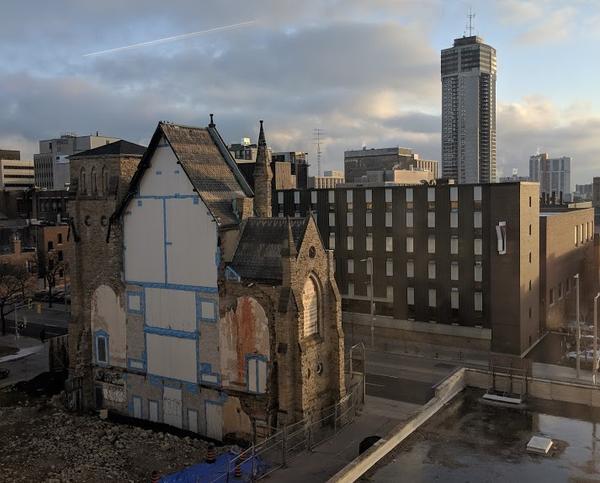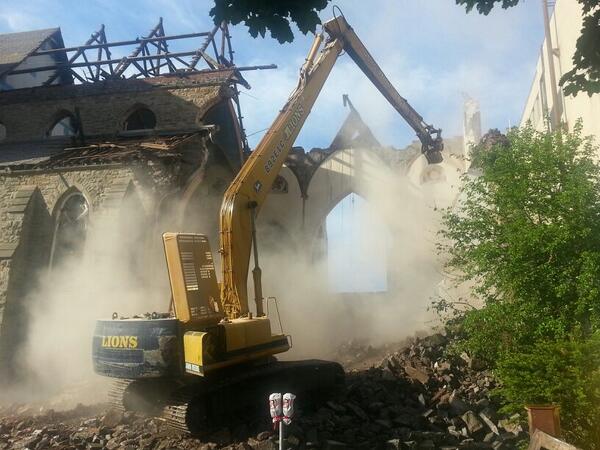The minor variance process has become a political tool that developers can use to go around the community, and even the City's bylaws, in order to work out their own arrangements behind the scenes.
By Cameron Kroetsch
Published March 05, 2019
People have been talking and fighting about the redevelopment at the site of the former James Street Baptist Church for years. There's a long history here.

Overlooking the remains of James Baptist Church (RTH file photo)
While I appreciate the rich and interesting history of this site, this article definitely won't be a walk down memory lane. Others have written about this before me and I'm not too interested in going back (if you are, I'd start with this article by Ryan McGreal from 2014).
More recently, the new owners of the site, Hue Developments, put in an application for a "minor variance" to the Committee of Adjustment. In their application there was an amendment to change the building from 30 storeys to 31 storeys and it got a reaction from some folks in the community, myself included.
Objectively, I can see how this might seem a like a really pointless discussion in the first place. Who really cares about one more storey when we're talking about a 30 storey building? The answer might surprise you: almost no one. This wasn't the reason for the reaction from the community, even if it was what triggered it.
That's why I'm writing about this. I think it's important to expand on the nuances here and make it clear what's going on for those who haven't spent much time diving deep on development applications.
For the record, I've always supported this project, just not the process. I've been and will continue to be critical about how we find ourselves in situations like these, who made the decisions to get us here, and what the City must do if it's committed to being more transparent and accountable.

Lanterns celebrating Vietnamese New Year under the hoarding in front of James Baptist Church (RTH file photo)
It's all a bit exhausting. Tracking a development application is a feat for the average resident. Suffice it to say, it's not something that most have the time or ability to do and usually requires a concerted group effort (even if just to rally and prop up the handful of people who are doing most of the work).
Most of that work is a careful balancing act. It's about wanting to see a good project come to completion quickly while remaining vigilant as a community. This work is also done in the context of a host of larger than life characters who are all trying to squeeze as much money as possible out of the tiny parcel of land they own. There's a lot at stake.
It's also incredibly tedious. It's keeping track of measurements, dates, application numbers, and a bunch of other random and sometimes inconsequential data. It's often gathered in whispers, files that shouldn't be seen, and through carefully crafted questions at exactly the right moment.
And, in a way, the entire process is set up to be somewhat adversarial. This doesn't mean that the community is always against a particular development project but that those of us doing this work must take on a certain affect, disguise, and mantle in order to do what's generally necessary to keep ourselves and our community "in the know".
Paying attention to site applications, development plans, and minor variances is all part of this work and necessary to staying engaged.
At this point I'm fairly suspicious of minor variances. I wasn't always this way but I've watched the minor variance process be used to work around the City's consultation and engagement model to expedite something at the last minute.
The way we found ourselves with a partly demolished church in the first place was the result of a process that began with a minor variance at the Committee of Adjustment. Raising an eyebrow at this stage is incredibly reasonable.

Three-quarters of James Baptist Church was demolished under a 'minor alteration' in 2014 (RTH file photo)
There are other examples of the same across the lower city. For those of us who watched what happened in the Stinson neighbourhood, a recent decision around a similar minor variance caused the same kind of reaction. At the last minute and without consultation, an additional storey was added to the "Vista Condos" on Charlton Avenue East. The issue there was more complicated than I'll get into, but suffice it to say that despite settling on the matter, the owner used an application for a minor variance to the Committee of Adjustment to get the number of storeys increased from five to six.
The minor variance process has become a political tool that developers can use to go around the community, and even the City's bylaws, in order to work out their own arrangements behind the scenes.
I'm not saying that this is always the case or that Hue Developments (the current owner of 98 James Street South) is doing this. What I am trying to make clear, however, is that this happens far too often in Hamilton and has become a recurring theme in discussions about development in Ward 2.
So, the fact that it appeared that the minor variance process was being used to "get another storey" set off alarm bells right away. I'm not the only one who has been trained like a Pavlovian dog to respond when I hear the words "minor variance". It's a sad thing, but a thing nonetheless.
I went to a meeting two days before the minor variance application was heard at the Committee of Adjustment, to listen to a detailed pitch from the developer about the project.
I was impressed by what seemed to me to be a cohesive plan. I've been to enough of these now to understand the difference between a developer who is trying to meet the community halfway and one who has shown up, just in time, to tell the community what they're going to get. This was definitely much more of the former than the latter.
During the Q&A after the developer's presentation, three separate people asked very pointed questions about the height that all essentially amounted to: "Are you saying that the entire height of the building, including all the mechanicals, will be 30 storeys?". The developer's answer was an emphatic and repeated yes. They echoed the number and promised people in the room that this was definitely the final word on the subject.
For people ardently following all the details, many of whom were in the room, this was finally a chance to confirm and put to rest some suspicions. Getting a chance to hear this right from the development team is a rare and often important opportunity. This was one of at least 20 questions asked after what seemed like about a 45 minute presentation.
So when the Spectator's Matthew Van Dongen reported that the Committee of Adjustment had approved a modification from 30 storeys to 31 storeys, this understandably caused some concern. This was especially the case for those of us who had just been told emphatically, two days prior, that it would be no more than 30 storeys.
In a practical sense, I couldn't care less if it's 30 or 31 storeys but I understand why others in the room were asking this question.
The number 30 isn't completely arbitrary. The "Downtown Secondary Plan" and appeals to the Local Planning Appeal Tribunal (LPAT, formerly the Ontario Municipal Board) reference this number quite a bit. It's the de facto number that the City has put forward as the "upper height limit" (in storeys) for building downtown based on the height of the escarpment.
Perhaps interestingly, the City doesn't think the number of storeys is always relevant. I understand their position. Since storeys can vary in height by as much as 25 percent, using them as a term of measurement can give a false sense of height. Measurements in metres are much more accurate.
A good example of this is the existing 12-storey building at the corner of Spring Street and Main Street East and the proposed 16-storey building at 210 Main Street East (across Spring Street). They're practically the same height in metres but they differ in height by four storeys.
Still, when the number of storeys begins to inch above 30 it signals to keen development watchers that the conversation may be shifting to redefining the "upper height limit". It's a valid point of inquiry and concern.
Nothing made that point clearer than when a group of developers filed an appeal against the minor variance application at 98 James Street South. Why was an appeal filed by another developer?
Because the City has drawn a metaphoric line in the sand around this magic number of 30 storeys and has denied applications by other developers who planned to exceed it. When the application for 98 James Street South was modified from 30 to 31 storeys, it was an opportunity for other developers to use the appeal process to pressure the City and LPAT to force an amendment to the "Downtown Secondary Plan" to increase the "upper height limit".
I understand why they would do this. Every extra storey is additional profit for a developer, so there's quite a bit of incentive here for them to continue to push to get what they want.
The real issue at hand here, and the reason there was a reaction in the first place, is because there's a lack of trust.
Across the city, and in this case specifically, it's been hard to build trust between developers and the community. There are many reasons for this, but the long and short of it is that trust is fragile and we must all nurture these relationships if we intend to build and rebuild them.
In relationships where trust has broken down, the little things matter. Small changes can signal a future pattern of behaviour or even a blatant deception.
When a developer is being blatantly deceptive, small lies can easily reveal bigger future problems and reacting immediately to them is an important tactic in clearly establishing a position as a community. After all, in some situations, especially those that might find their way to the courtroom, this is all part of how negotiations happen (but that's for another series of articles).
The point is: small deceptions, like might have been the case here, are often the only way that the community is able to clock when a developer is up to no good.
In this instance, as I've learned, that doesn't appear to have been the case, but it helps to explain why I and others reacted the way we did.
The developer seems not to have considered how important that trust was (and is) to nurturing this relationship. While a lot of this may have happened at the "eleventh hour", a quick email to the community giving us the heads up about this would have gone a very long way.
But as I now understand it, the developer themselves may not have even known about the additional storey at all.
The developer was likely in the dark because the process for submitting an application for a minor variance is pretty opaque. In brief, the developer (owner) puts in an application for a minor variance to the Committee of the Adjustment. This application is reviewed by a number of parties, including the Building Department. Seems pretty normal, right? Well, here's the part that gets tricky: sometimes the Building Department amends the minor variance application.
Because things have been missed in the past, the Building Department now goes out of its way to make sure that the information contained in the application is as accurate as possible. In this case, they did everyone a favour. The most recent drawings for the project (which were not shown in full to anyone at the community meeting, or discussed) show that there are in fact 31 storeys (including mechanical). What the Building Department realized, I think, is that the applicant had written down 30 storeys when they meant 31, so they corrected this. Makes sense to me.
As I understand it, the revised application was circulated 17 days before, including to the applicant (owner) who seems to have missed this small change. Why was it missed? Because the height never changed from the original 106 metres.
Since additional storeys are permitted within the given metrical height it didn't raise any red flags and may have entirely escaped notice. I'm not excusing the developer from the burden of reading their own application closely, but mistakes happen and that's perfectly understandable.
My first thought is that we need to have more inclusive discussions. The community, developer, and staff should be able to find ways, outside of the political process, to meet and discuss this all together in a relatively informal setting.
Had staff been at the community meeting, for instance, this likely would have been resolved then and there. They would have pointed out the height in metres and clarified some of the finer points that the developer had overlooked as significant to the community. Staff have more experience working with residents and understand the kinds of questions we're likely to have.
There are small things that I think would likely also help and possibly even aid developers in their own deliberations. An easy one, in my view, is the City getting comfortable with the practice of tracking changes in documents and then circulating those changes. This would make it so much easier for changes to be reviewed. If this can't be done digitally, it can certainly be done the old-fashioned way so that drafts can be shared with all concerned parties (including the community) before they're finalized.
More than all of this though, we need to continue to urge the City and property owners to make their processes and documents public in a timely manner (more than the bare minimum required by law).
If there are changes, the City and the developer should err on the side of just extending the process by an additional 30 days. The fatigue I mentioned earlier, on all sides, makes the City and the developer resentful about extending timelines. I get that and I understand that for property owners this can even mean additional costs. I'd argue, however, that the loss of goodwill and trust is much more damaging and costly than another 30 days.
Those extra days give us all breaths of fresh air, moments to regroup, and time for reflection. I find that we all make better decisions when we have them. Developers, their consultants, and property owners continue to underestimate how much it means to show some leniency and to give people a little bit more time. We're all volunteers. We're likely fitting this one thing into our schedules among a dozen other things in any given day, week, or month and another 30 days feels like an ocean of time to digest, think, meet, and talk.
It's often difficult to figure out where "someone stands" on development in Hamilton. I understand that frustration and mistrust. We're less likely to notice the nuanced points that aren't clearly "in favour of" or "against" development in the core and more likely to assume that people are firmly on one side or the other.
It's rarely that way in my experience. Most of the people I've spoken to at length about development feel very grey about all of it. Their opinions vary from site to site and after a relatively short conversation they're usually happy to hear or consider another point of view.
Most of the reasons that people seem concerned or react to a particular piece of news has much less to do with being in favour of something or against it and much more to do with why, how, and when something is happening.
Generosity, on all sides, is the only way forward in continuing to build meaningful relationships and lasting trust and I hope that this situation has made that clearer. I've certainly learned a lot, especially about how grey areas can be uncomfortable but necessary spaces to have the conversations we need to get closer to the answers we'll never find in the black and white of it all.
By KevinLove (registered) | Posted March 10, 2019 at 15:35:24
Kitty-corner to the GO train station is precisely where we want the highest density to be.
You must be logged in to comment.
There are no upcoming events right now.
Why not post one?